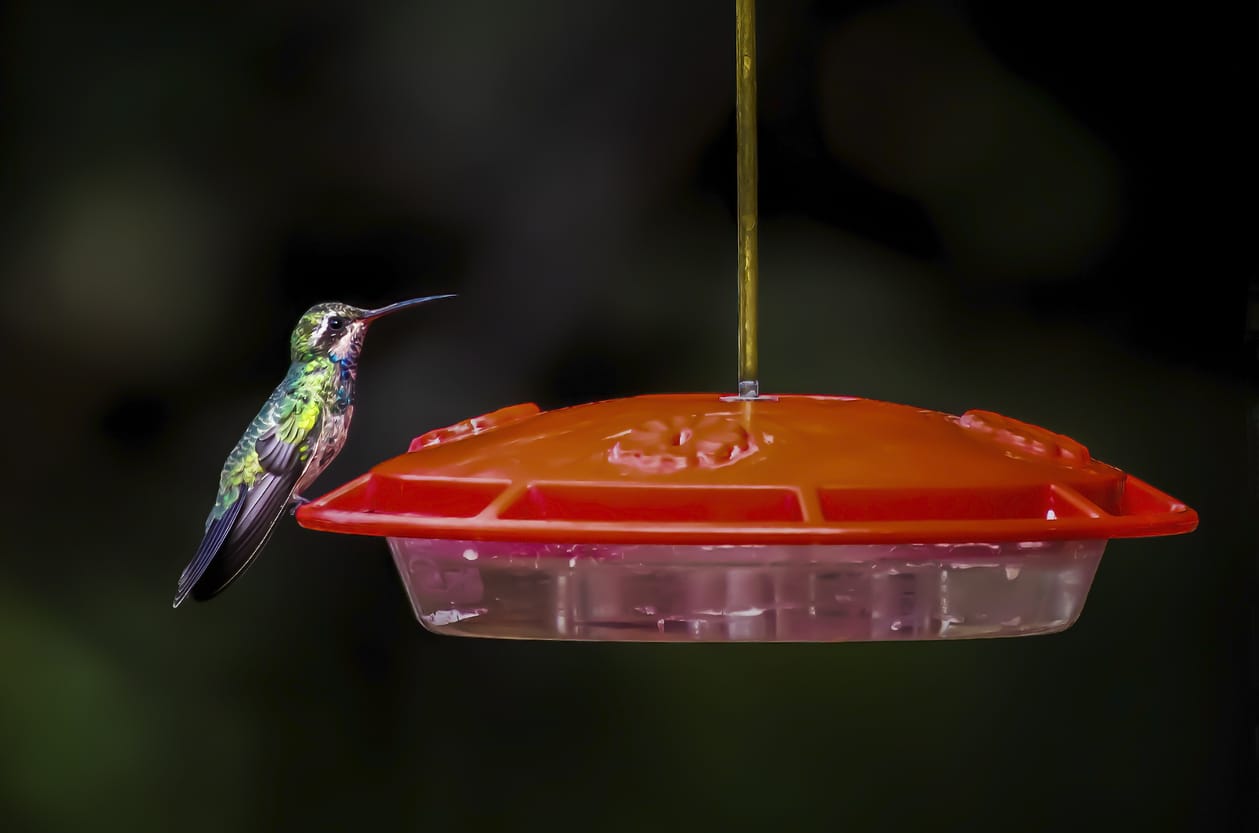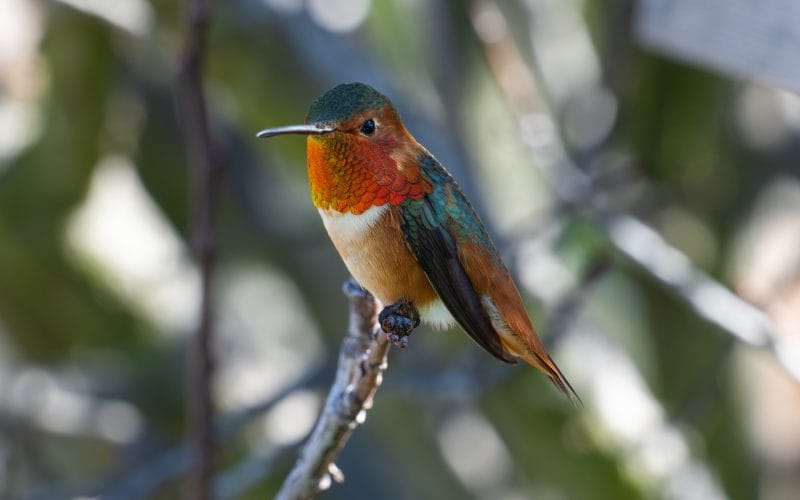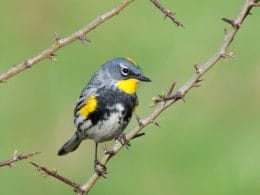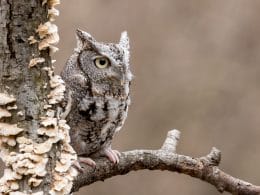It’s always a joy to spot a colorful hummingbird. Hummingbirds are fascinating, and there’s always something new to learn about them.
Despite their small size, these birds are agile flyers and fearless birds. They’re not scared to chase away larger birds that come near their food sources.
They’re also the smallest long-distance migratory birds. It’s impressive the distances they can cross in one flight.
Because we know many people love to see hummingbirds in their backyards and learn about them, we created a list of the nine species of hummingbirds that you can find in Virginia.
Let’s get started!
9 Species of Hummingbirds in Virginia
According to the VSO Field Checklist of the Virginia Society of Ornithology, nine species of hummingbirds can be found in Virginia.
Two of these species are common in the state. These are Ruby-throated and Rufous Hummingbirds.
The other seven species are rare or accidental in the state. These include the Rivoli’s, Black-chinned, Anna’s, Calliope, Allen’s, Violet-crowned, and Buff-bellied hummingbirds.
Here’s a list of these nine beautiful, tiny hummingbirds:
1. Ruby-Throated Hummingbirds

- Scientific Name: Archilochus colubris
- Length: 3 to 4 in
- Weight: 0.1 to 0.2 oz
- Wingspan: 3 to 4.5 in
The Ruby-throated Hummingbird is the only breeding species of hummingbird in North America. It’s also the most common.
In Virginia, these birds start arriving in April during the spring. Males usually arrive earlier than females, by one to two weeks.
These beautiful birds hang out in Virginia for the entire summer and start their migration journey back to their wintering homes in September or mid-October. They winter in Central America, particularly Mexico.
You can also find some Ruby-throated Hummingbirds wintering in Virginia. However, this is not so common.
Top Tip: Ruby-throated Hummingbirds have emerald or golden-green upper bodies and grayish underparts. You can differentiate between males and females of this species by their throats.
Males have ruby-red throats that the females don’t have. This is how they got their name.
These hummingbirds are found in all parts of Virginia, especially in open woodlands, gardens, meadows, and backyards. They’re common visitors to hummingbird feeders.
Setting up a sugar-water mixture feeder or planting tubular flowers are good ways to attract these birds to your yard. However, keep in mind that they’re extremely aggressive and territorial.
They like feeding on the nectar of tubular flowers that are usually in red and orange colors. They also pluck insects from the air or from spider webs.
2. Rufous Hummingbirds

- Scientific Name: Selasphorus rufus
- Length: 2.8 to 3.75 in
- Weight: 0.1 to 0.2 oz
- Wingspan: 4 to 4.5 in
Rufous Hummingbirds are not common in the eastern states. However, you can see them during their migration journey. Also, some of them might winter in Virginia.
The best Virginia cities to spot these hummingbirds are Norfolk, Lynchburg, Charlottesville, and Richmond. They might also visit the town of Washington.
If you live there, you can easily attract these birds to your backyard. Provide hummingbird feeders or provide some tubular flowers.
You should know that the Rufous Hummingbird is the most aggressive of all hummingbirds, despite being among the smallest birds in the world. It cares mainly about its food—even more than mating.
A male won’t mind chasing a female Rufous away from its source of food. So, leaving some perches out in your backyard is also another way to attract them to your backyard feeder.
Rufous Hummingbirds are gifted with an excellent memory of locations. They might return the next year looking for your backyard feeder where it has been the previous year.
To identify Rufous Hummingbirds, look for their glowing rufous plumage. Males have coal-like plumage that glows in the bright sunlight, hence the name.
Their iridescent-red throats differ in color from red to orange to green, depending on the light. Females, on the other hand, lack the rufous plumage.
They have green upper bodies and a spot of orange on their throats. The rufous color is only found on their flanks.
3. Rivoli’s Hummingbird

- Scientific Name: Eugenes fulgens
- Length: 4.3 to 5.5 in
- Weight: 0.2 to 0.35 oz
- Wingspan: 7.1 in
Rivoli’s Hummingbirds are among the accidental species in Virginia. It’s very rare to find these birds in the state. However, they’re still worth mentioning in our list.
You might know this bird by the name Magnificent Hummingbird. That was its official name until 2017, when the Magnificent was split into two species: Rivoli’s and Talamanca Hummingbirds.
This species is one of the most colorful. Males have dark plumage with blackish underbodies and green above. The tails are all dark.
Top Tip: You can see their emerald gorget and purple crown in good light. Females aren’t as colorful, though. They have greenish upper bodies and grayish underparts.
The tails of the females have pale tips. The common thing between males and females is the white mark behind their eyes.
Rivoli’s are found nesting in mid-elevation forests and meadows, especially near streams and creeks. Despite their larger size compared to other hummingbirds, they’re peaceful birds.
They don’t attack other hummingbirds at flowers or feeders. Instead, they use a technique called training, where they travel along a route of widely spaced groups of flowers.
4. Black-Chinned Hummingbird
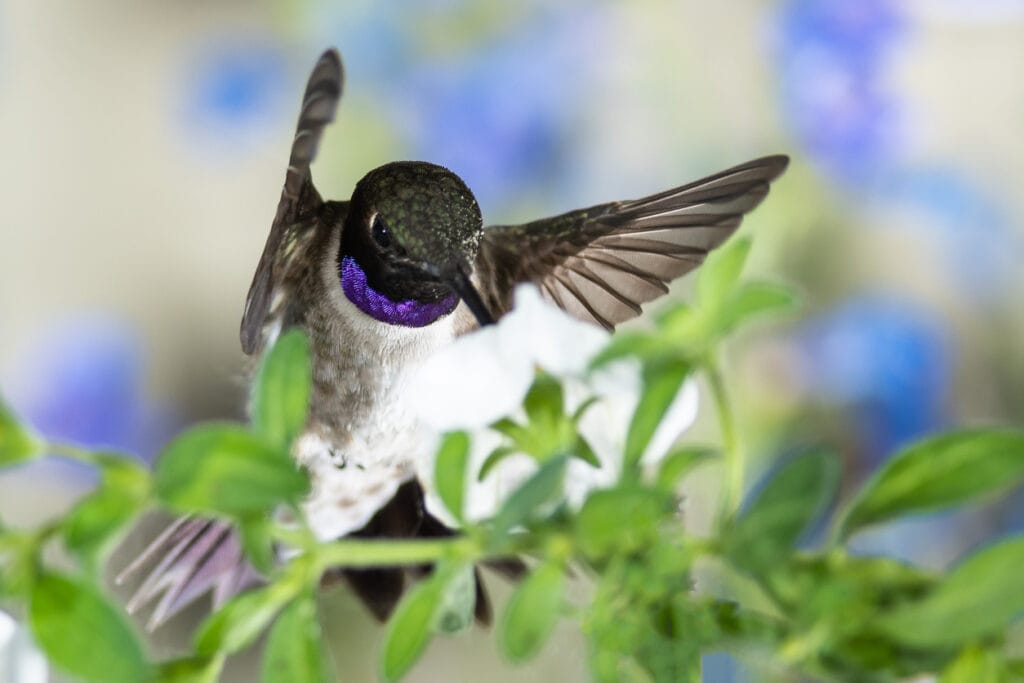
- Scientific Name: Archilochus alexandri
- Length: 3.5 in
- Weight: 0.1 to 0.2 oz
- Wingspan: 4.3 to 5 in
Black-Chinned Hummingbirds are also accidental species in Virginia. However, they’re more common than Rivoli’s. All their sightings occur in Northampton and Williamsburg.
To have a bigger chance of spotting these birds, you need to follow their migration route. These birds breed during the summer in western states along the route from British Columbia to Baja California.
After the end of their breeding season, they start their migration journey to their wintering homes in Mexico in September. So, keep an eye on them during their migration season in March and September.
Black-chinned Hummingbirds are metallic green above and on the flanks. Their name refers to the black chins that the males have and females lack.
Males also have black throats with an iridescent purple color that only shows in good light. In comparison, females have white throats with pale green.
The tongue of the black-chinned hummingbird is uniquely shaped to help it feed on nectar from flowers. It has two grooves through which the nectar moves.
This helps the bird retract its tongue and squeeze the nectar into its mouth. It also allows it to take about 17 licks of nectar per second.
When nectar is scarce, Black-chinned Hummingbirds feed on insects. These hummingbirds go into torpor on cold nights.
5. Anna’s Hummingbird
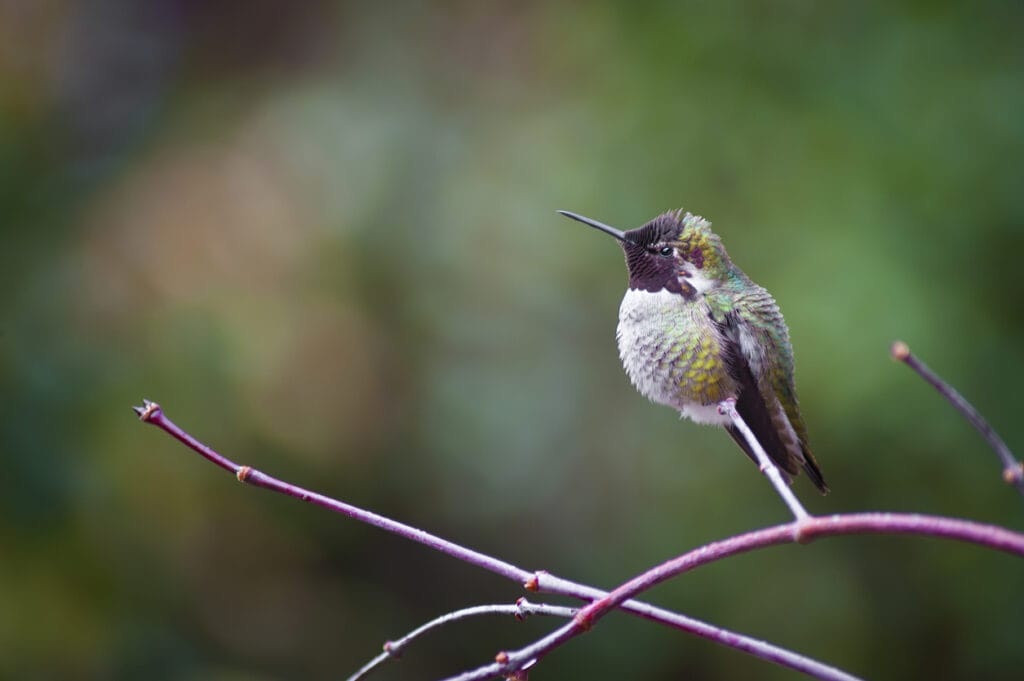
- Scientific Name: Calypte anna
- Length: 3.5 to 4 in
- Weight: 0.1 to 0.2 oz
- Wingspan: 4.7 in
This is another accidental species in Virginia. It was only spotted a few times in the state, especially around Lake Frederick.
Anna’s Hummingbirds are hard to spot even in areas where they are common, like along the Pacific Coast. It’s weird, especially as they’re not migratory birds.
They’re gifted with amazing beauty, thanks to their colorful plumage. They’re mostly green and gray with no markings on their bodies.
Author Note: Males have iridescent reddish-pink feathers on their heads and throats that appear in direct sunlight. What’s odd is that females have a gorget as well, which isn’t common in hummingbirds. However, it’s a tiny red one, so it’s barely noticeable.
Anna’s males know how to make a strong impression. During their courtships, a male Anna’s can climb up to 130 ft into the air and then dive to the ground, making a noise with the tail feathers.
Some species of hummingbirds enter torpor in cold temperatures. Anna’s are among these species. They become inactive, and their breathing and heart rate slow down dramatically.
Once the temperature turns back up, they become active again within a few minutes.
6. Calliope Hummingbird
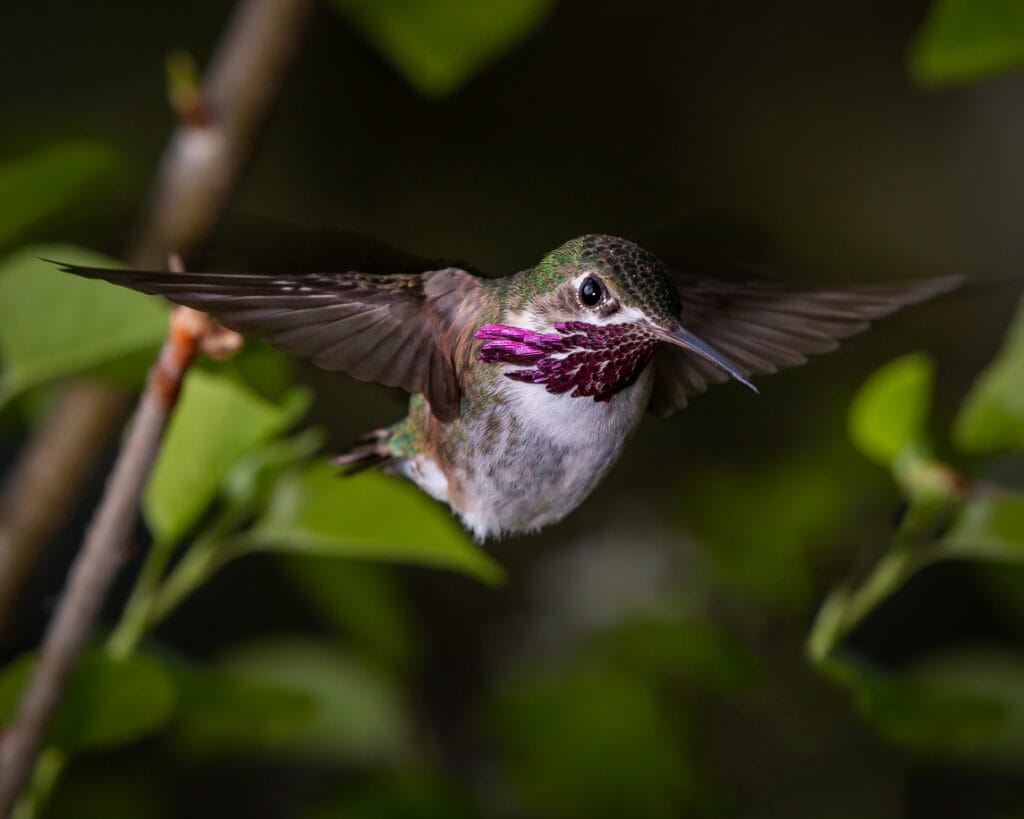
- Scientific Name: Selasphorus calliope
- Length: 2.7 to 3.9 in
- Weight: 0.1 oz
- Wingspan: 4 to 4.3 in
Calliope Hummingbirds are the smallest birds in the United States. They don’t weigh more than a ping pong ball. Though, they’re feisty little birds. You can see one chasing a Red-tail Hawk away.
The tiny bird is the smallest bird to migrate long distances in the world. They migrate 5000 miles from Mexico to the Pacific Coast in the spring.
Calliope Hummingbirds are easy to identify with the magenta rays found on the males’ throats. Both sexes have greenish upper bodies. Males have greenish bellies, while females and juveniles have peachy underparts.
In their breeding homes, they prefer nesting in mountain meadows near streams and in open forests that result from fires. They’re also regular visitors to backyard feeders.
They feed mainly on flower nectar and insects. Additionally, they catch flying insects from the air and usually forage low to the ground looking for a food source.
The Calliope Hummingbird is an accidental species in Virginia and has only been seen a few times. Its sighting mostly occurs near Charlottesville and around Nokesville.
7. Allen’s Hummingbird

- Scientific Name: Selasphorus sasin
- Length: 3.5 to 3.75 in
- Weight: 0.1 oz
- Wingspan: 4.3 to 4.75 in
Allen’s Hummingbirds are coppery orange and green overall. Males have coppery plumage on their tails, bellies, and eye patches. They also have deep orange gorgets that are extremely beautiful.
Author Note: Females and juveniles are mostly bronze-green above with pale coppery sides. Although females don’t have a gorget, they have a small patch of deep orange on their throats.
Some people mistake this species with Rufous hummingbirds. It’s not their fault, though. They do look alike.
The only way to really differentiate between them is by the shape of their tails.
Allen’s breed in California and Oregon. In winter, they migrate back to their wintering homes in Mexico.
These birds are considered early migrants. They leave their wintering grounds in December and arrive at their breeding destinations by January. Some of them don’t migrate and stay all year in southern California.
Unfortunately, this species is accidental in Virginia. It’s only been spotted a few times near Richmond and Williamsburg.
However, there’s hope to spot this bird in the state. Just get your feeder ready during their migration season, and they might give you a visit.
8. Violet-Crowned Hummingbird
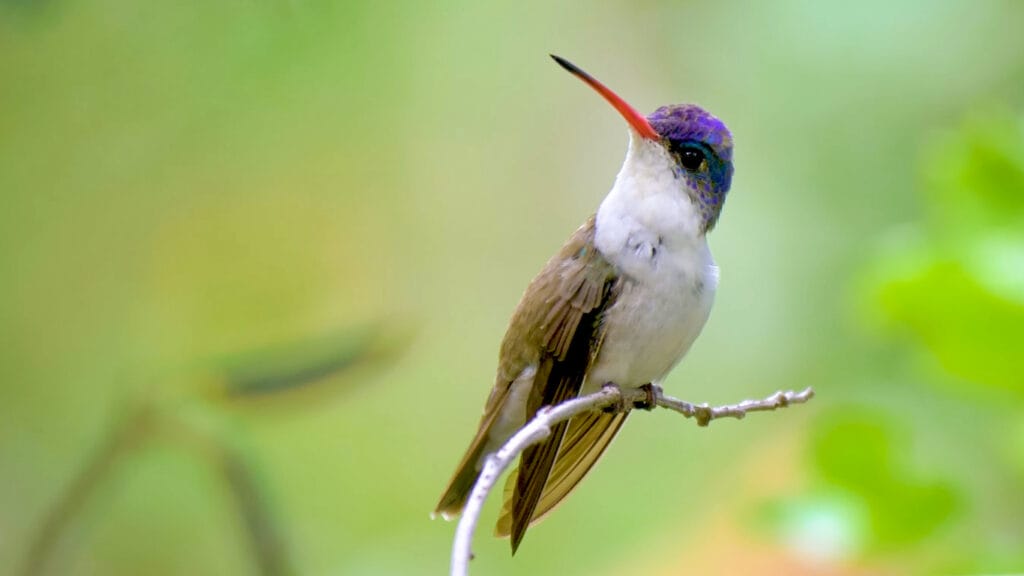
- Scientific Name: Leucolia violiceps
- Length: 4 to 4.3 in
- Weight: 0.2 oz
- Wingspan: 5.5 to 6 in
Violet-crowned Hummingbirds are uncommon in the United States. However, they’re regular summer visitors.
They’re mostly found in southeastern Arizona. There have been a few sightings of them in Virginia. Who knows, you might spot them one day!
To identify these beautiful hummingbirds, look for their clean white underbodies and bronzy green upper plumage. They also have a visible iridescent purple-blue crown and a distinctive white spot behind the eye.
Their bill is pretty distinctive compared to other species. It’s reddish-orange with a black tip. This species is the only species of hummingbirds in the United States that lacks a colorful gorget.
Violet-crowned hummingbirds like to nest in areas with sycamores and willows. They also forage in dry forests and meadows.
Like all hummingbirds, they feed on nectar from flowers and flying insects. These hummingbirds are among the larger species.
That’s why they’re members of the “humming order.” This order of larger hummingbirds chases away smaller species to keep all the sugary food sources to themselves.
9. Buff-Bellied Hummingbird
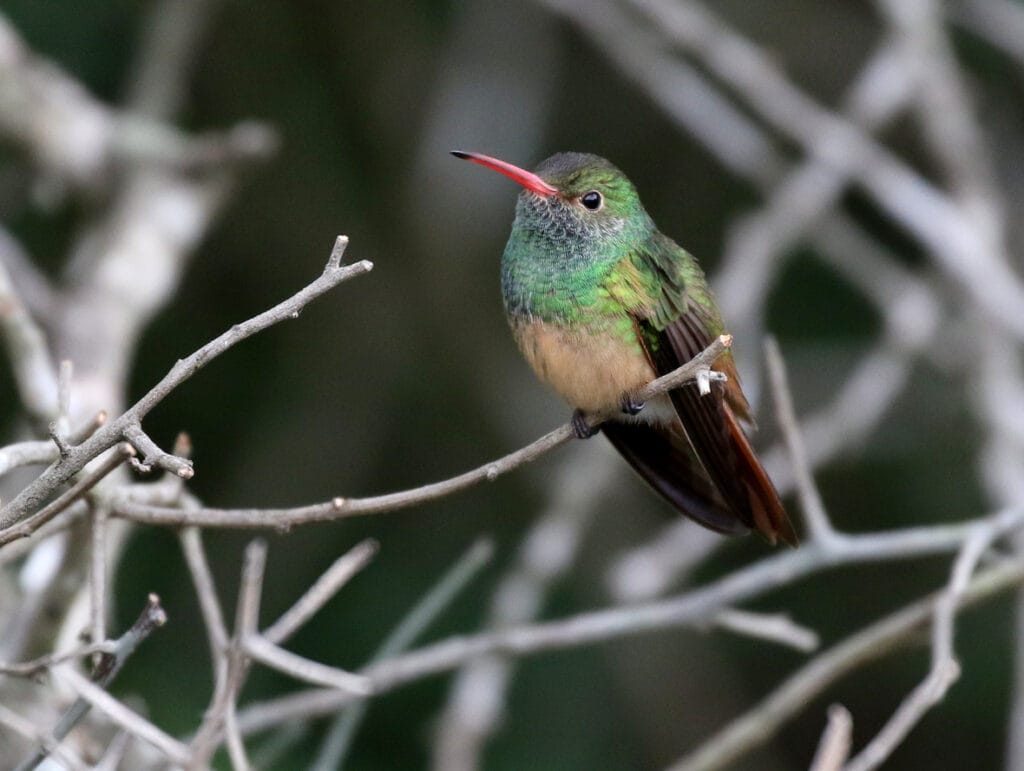
- Scientific Name: Amazilia yucatanensis
- Length: 3.9 to 4.3 in
- Weight: 0.1 to 0.18 oz
Although the Buff-bellied Hummingbird is expanding into the coastal states, it’s still a minor breeder in the United States. It breeds in Texas, Particularly along the Gulf of Mexico, from Mexico to Texas.
During different times of the year, this hummingbird might wander off to other states, such as Alabama, Arkansas, Louisiana, and Virginia.
Author Note: Louisiana welcomes most of the wandering Buff-bellied Hummingbirds after the breeding season. They prefer habitats with open woodlands, suburbs, thorn forests, and parks with flowering plants.
They feed on the nectar of flowers and sugary mixtures at feeders, where they chase off smaller hummingbirds. They also feed on insects to supply their bodies with the necessary protein, especially during the breeding season.
Buff-bellied Hummingbirds are the largest species of hummingbirds in the United States. They have bronze-green plumage with buff bellies, hence the name.
Their throats and breasts are iridescent blue-green that appear gray in poor light.
Final Words
If you want to attract hummingbirds to your backyard, then you must set up your feeder in early April in Virginia. It’s best to leave out some perches as most species are territorial and like to perch to monitor their food source.
Also, growing tubular flowers in your garden will provide more motivation for hummingbirds to visit your backyard. When making your sugar-water mixture, use one part of refined white sugar and four parts of water.
We hope you enjoyed our guide on the most common hummingbirds in Virginia!
FAQ
Hummingbird feeders in the towns of Norfolk, Lynchburg, Charlottesville, and Richmond and Washington may support a range of hummingbirds.
The Ruby-throated and Rufous Hummingbirds are most common in Virginia.
To find out where recent sightings of hummingbirds have been, try eBird. You can search for the latest sightings or particular species or what has been seen in a certain area.




